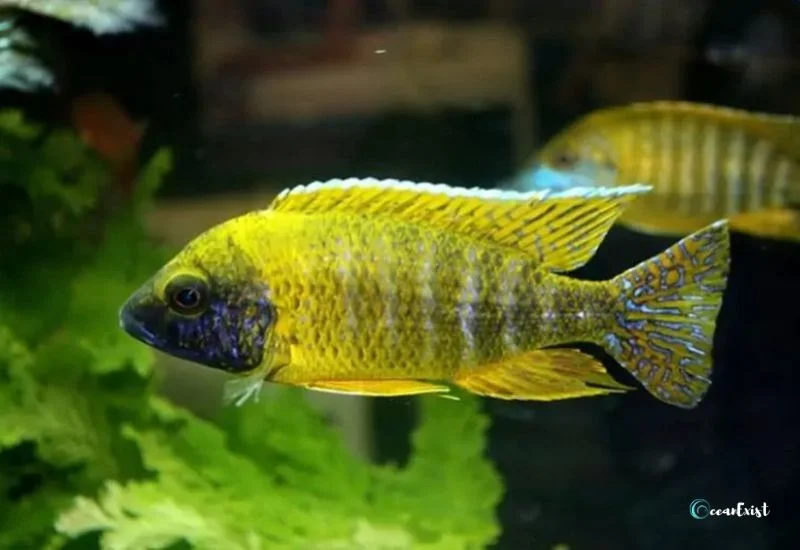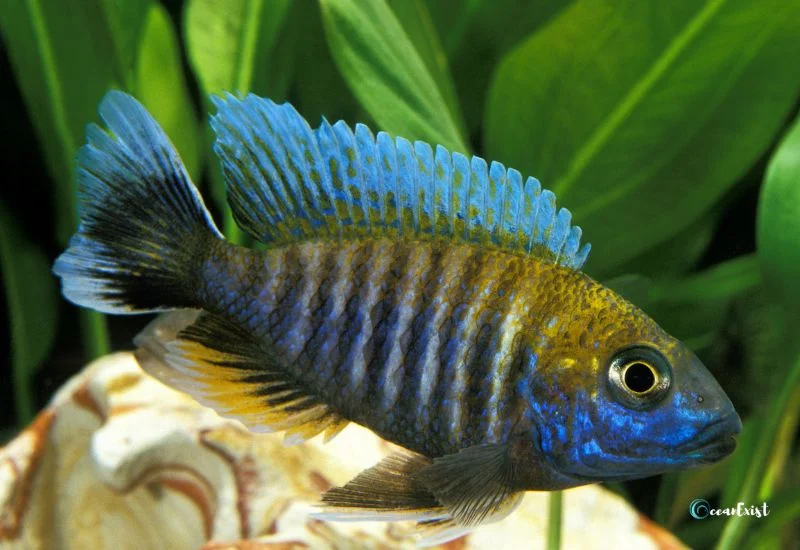Do you know that Peacock Cichlid is considered one of the best choices for aquarists, not because of its low maintenance and ease of care but because of its beauty?
There are multiple variations of cichlids found all around the world. But they originally belonged to Malawi, an African lake.
They exhibit dimorphism, which means that the male Cichlids have vivid coloring, while female Cichlids are usually colorless.
These are assorted freshwater fish that can be seen in vivid colors, from red and yellow to purple. They are very easy to care for and are very friendly and peaceful. But, due to their territorial behavior, they may get aggressive when they are captivated in low tank space.
Aulonocara Overview
| Scientific name | Aulonocara |
| Size | 6 inches |
| Nature | Friendly, Peaceful |
| Temperament | Semi Aggressive |
| Temperature | 25-26°C |
| Water pH | 7.8-8.6 |
| Diet Type | Omnivore |
| Water Hardness Level | 4-6 GDH |
| Breeding | Mouth Brooder |
Size and Lifespan
Mature Peacocks Cichlids may grow up to 6 inches. Male Cichlids are an inch larger than female Cichlids.
They have a lifespan of up to 6-8 years. But, If We provide them with a rich protein and nutritious diet and keep them in a healthy environment, their lifespan can increase by up to 10 years.
Appearance
These are small, colorful fish with torpedo-shaped bodies. Their colors depend on their Cichlid family type and the area of Malawi Lake to which they belong.
Male Peacocks usually have luminous coloring, glowing the overall aquarium with their physical appearance. But, female Peacock do not exhibit colors, and they give an albino-style look.
Cichlids Types
OB Peacock
The OB Peacocks are not native to Lake Malawi. They are hybrid species where male Cichlids have a combination of red, blue, yellow, or white, while females have black and silver coloring.
There are some black patches all over their body. You will also observe black spots on their caudal and dorsal fins. OB Peacocks may grow up to 6-8 inches in size.
German Red Peacock
Quite interestingly, German Red Rock is not a native Maliwai or hybrid Cichlid. However, this is a line-bred species, which means that breeds frequently choose to mate with parents who are not closely breeding.
They can grow up to 5-8 inches in size. Males exhibit beautiful shades of red and blue, while females have black and shimmering silver color bodies.
Blue Peacock Cichlid
The Blue Cichlid, also known as Aulonocara Nyassa, is the most popular type of the family. They originally belong to Malawi Lake and grow up to 4 inches in size as mature.
They have a blue-colored body with vertical stripes scattered all over their body from dorsal fins to caudal peduncle.
Dragon Blood Peacock
The Dragon Blood Peacock is a hybrid Cichlid that does not originate from Malawi. The male Peacocks have bright orange and pink color shades, while females have faded orange and cream color bodies.
They are also compared with Strawberry Peacock Cichlids due to their coloring. They can grow up to 5-8 inches in size.
Strawberry Peacock Cichlid
The Strawberry Peacock Cichlid is a very stunning, beautiful coloring type. They exhibit vibrant red and pink coloring, and there are strawberry-like dots scattered all over their body.
Peacock Cichlid Tank Setup

Tank Size
Peacock Cichlids possess a territorial nature and require a larger tank space. If you want to house 4-6 Cichlids, you will require a tank of 100 gallons of water capacity.
Heater
The Peacock Cichlids belong to the tropical fish family. They require a slightly warmer temperature. So, You will need to install a heater in the aquarium. Keep a thermometer close to the aquarium to check the water temperature frequently.
Filtration
There are no hard and fast rules regarding filter selection for your Peacock Cichlid. You can install any type of filtration system in the aquarium.
Lighting
The Peacock Cichlids like dim lighting in their captive environment. So, install a lighting system that provides them with their natural habitat.
Substrate
The Peacock Cichlids flourish well in the underlying layer of tropical waters of Malawi Lake. The substrate may include sand, small stones, and fine sand gravel.
Don’t use stones or decor items with sharp edges because they may hurt the fish.
Plants For Cichlids
You should consider vegetable-based plants in your aquarium decor. Here is a list of plants that can be grown in the aquarium for Cichlids:
- Java Moss
- Round Leaf Ludy
- Vallisneria
- Anubias
Best Tank Mates For Peacock Cichlids
The best tank mates for Peacock Cichlids are fish that grow in the same water conditions. Fish from Malawi Lake will probably be the best choice for housing with Cichlids.
The rule of thumb is “Try to house fish which float on upper layers of water.” It will keep the environment peaceful, and there will be ample space for Cichlid to roam around.
Do not put fish with aggressive behavior, such as Tiger Barbs and Betta Fish, with Peacock Cichlids. Here is a list of the best tank mates for Peacock Cichlids.
- Rainbow Sharks
- Red Tail Sharks
- Plecos
Peacock Cichlid Diet

Peacock Cichlids are omnivores and eat vegetable-based plants. But they like to swim in the substrate and eat whatever they find in the water. They eat small insects, zooplankton, algae, and other plant matter.
It is advised to feed them with the same varied food as found in their natural habitat. You can feed them fresh fish flakes, small insects, brine shrimps, and other plant food.
When you plan to feed them, make sure that food sinks deep in the water, as these fish spend most of their time in the underlying layer of substrate and searching for food there.
Make a plan to feed Peacock Cichlids. Try to feed them in batches and throw a small pellet of their food in the aquarium to ensure proper digestion and prevent overfeeding and obesity.
Peacock Cichlids Breeding
Breeding Peacock Cichlids is a very simple process. There are certain conditions that you must follow in order to encourage the male Cichlids to mate.
- Tank size should be large enough to give them their natural habitat.
- There must be ample space specifically designed for their privacy.
- There must be decor elements and plants in the aquarium.
- There should be only one male in the aquarium.
- Because too many males will fight over the territory’s possession and compete for their female mating partner.
- You can raise the temperature to urge the male Cichlid to mate.
Male Cichlids usually dance from side to side to attract female attention. When females agree, they breed in private nests. Male Cichlid fertilizes the eggs in the nest. As these fish are mouth brooders, females keep eggs in their mouths. This process may take up to one month.
After one month, you will see one dozen or more fryers in the aquarium.
Common Peacock Cichlid Diseases
There are some common freshwater diseases from which Peacock Cichlids may suffer.
Malawi Bloat
Malawi Bloat, or Dropsy, is a common disease in Peacock Cichlids. This disease is mainly caused by a poor digestion system and improper diet.
When you observe a pale body, no appetite, or laziness in a Peacock Cichlid, You may believe that it is suffering from Malawi Bloat.
If your fish is suffering from this disease, it will hardly try to go in water depth and search for food. Do not feed them dried or meaty food in this case. Feed them a diet with more fiber and vegetable-based food.
Mycobacteriosis
In Peacock Cichlids, this disease is due to rod-typed mycobacteria. In this disease, fish feel no appetite and show lethargic behavior.
You will observe a sunken abdomen and pale coloring in this disease. Any fish antibiotic treatment will cure the infected fish.
Always quarantine the infected fish to prevent the disease from spreading in the aquarium and infect other fish.
Frequently Asked Questions
Conclusion
In conclusion, Peacock Cichlids are the best choice for aquarists with their vibrant coloring and agile nature. They have a lifespan of almost 5-8 years and grow up to 6 inches in size.
Peacock Cichlids are omnivores who eat vegetable-based food, but they also like diets such as fish flakes, small insects, and brine shrimp.
Do not house them with other fish that have an aggressive nature, such as Betta fish or Tiger Barbs. Peacocks may suffer from common diseases which are caused by poor diet and improper water conditions in the aquarium.
